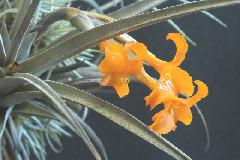
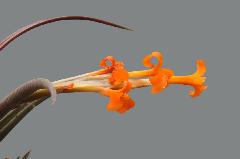

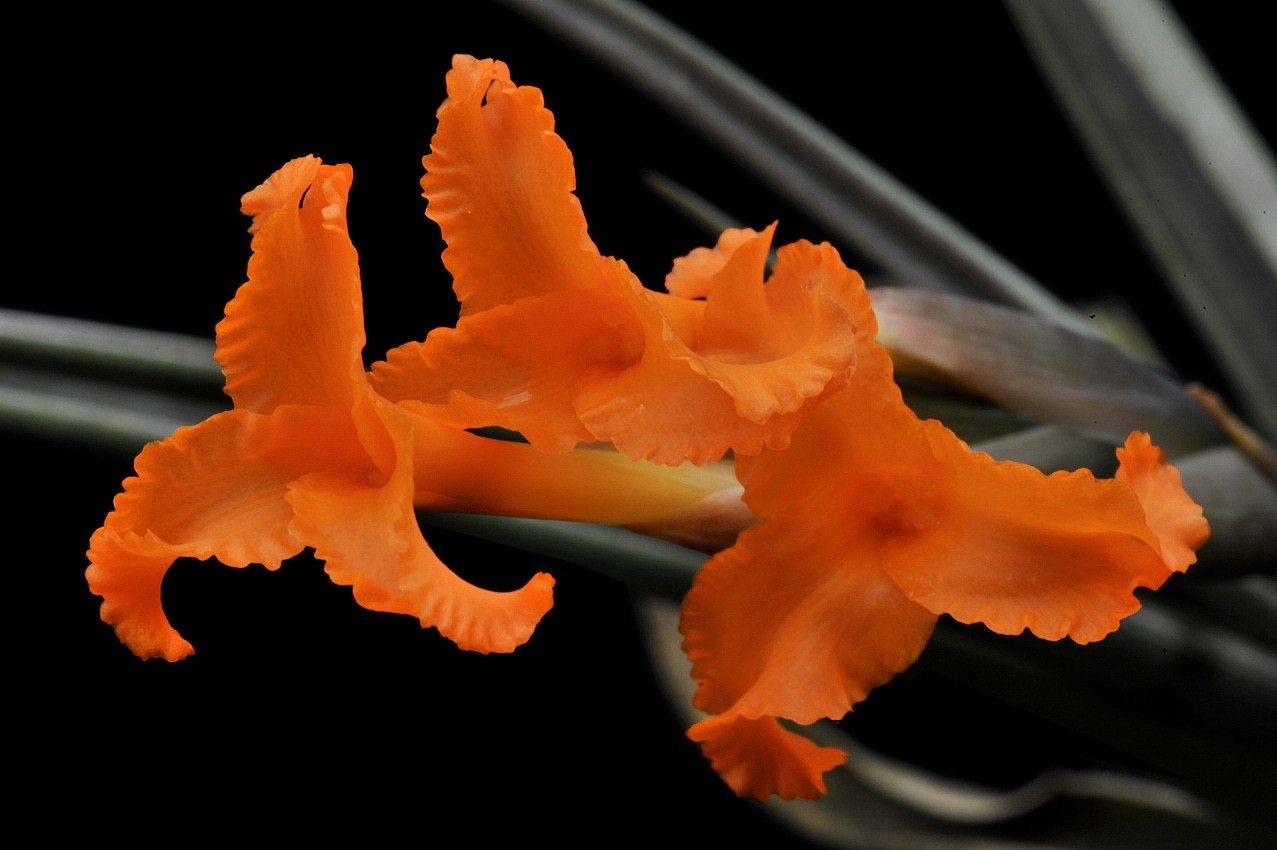
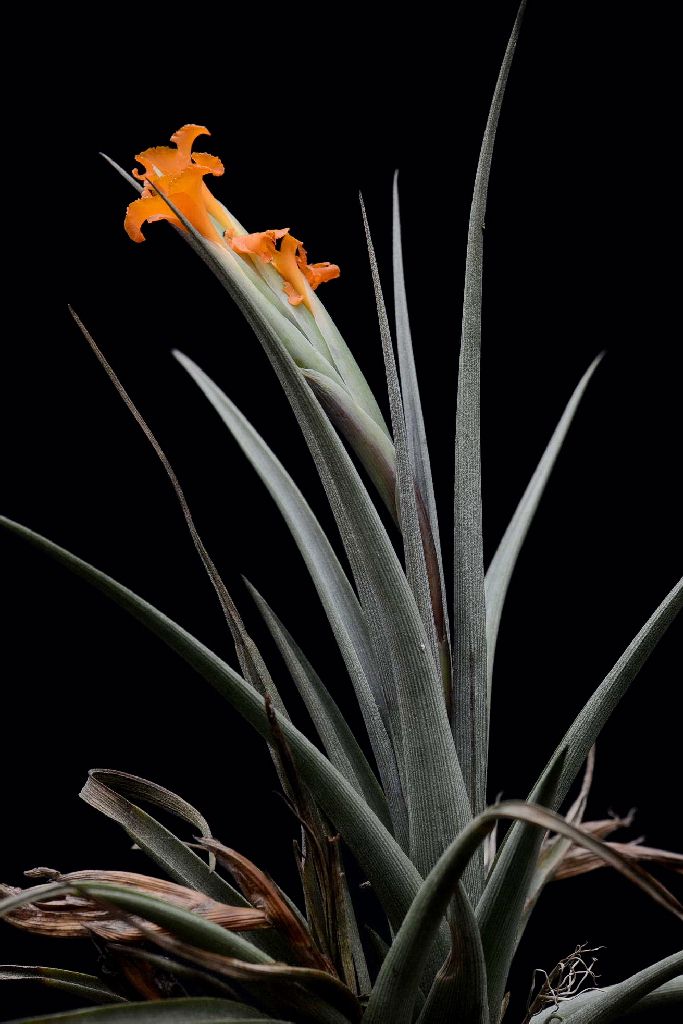
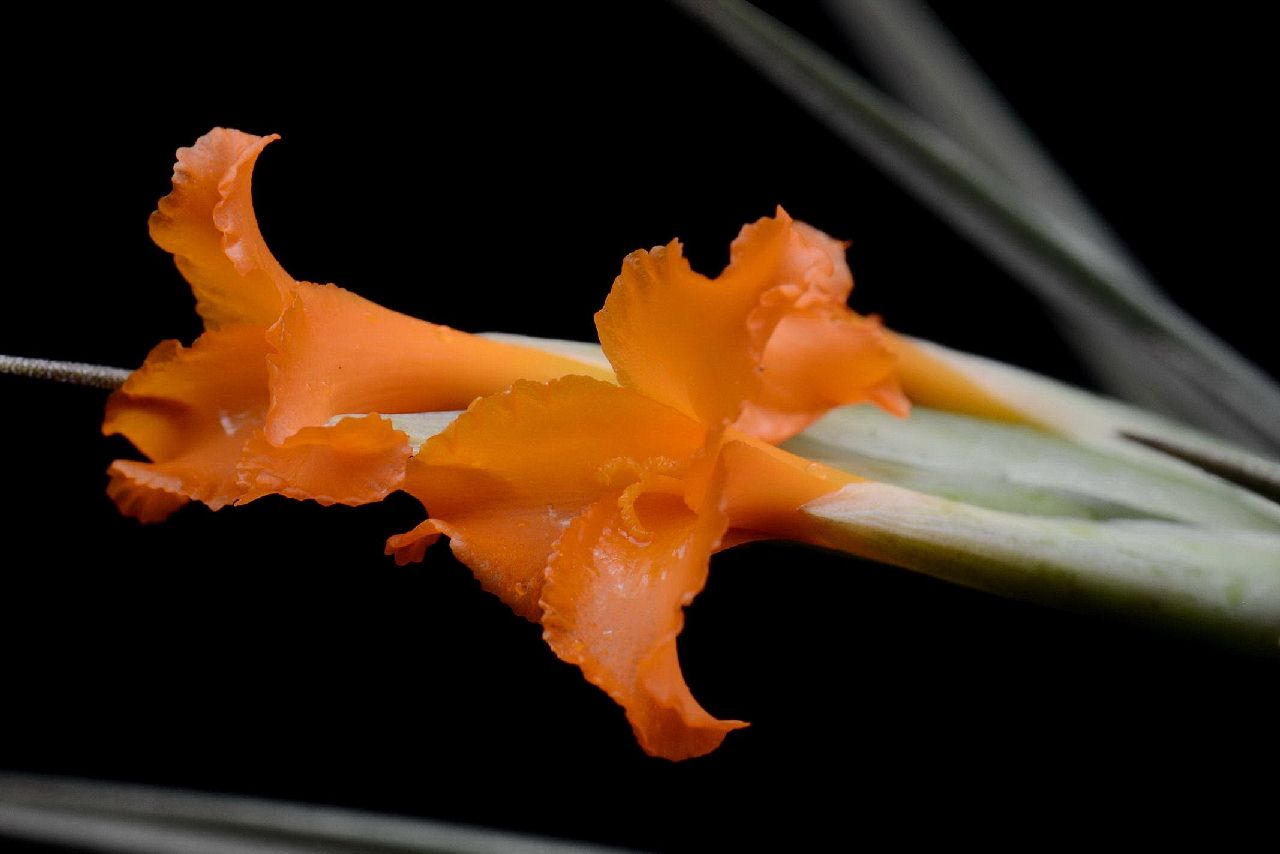
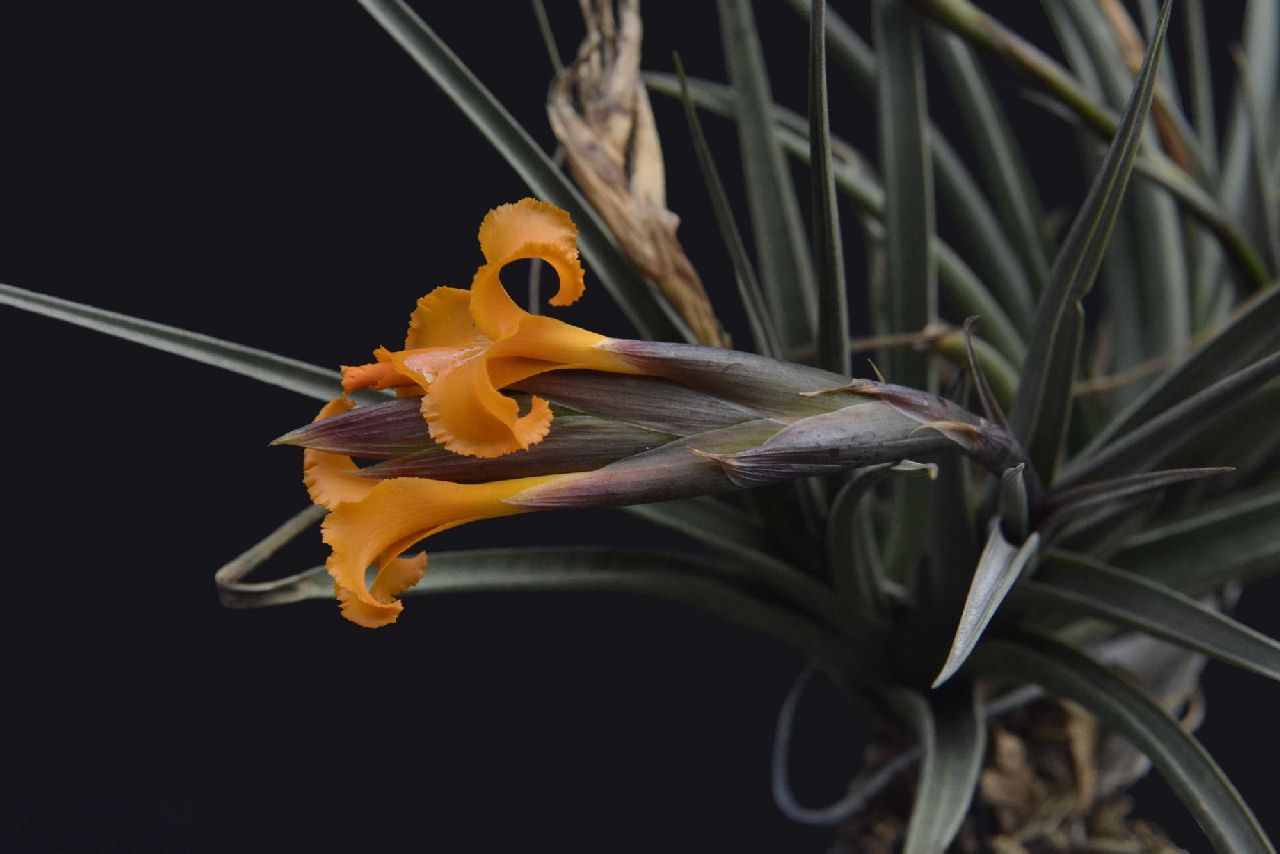


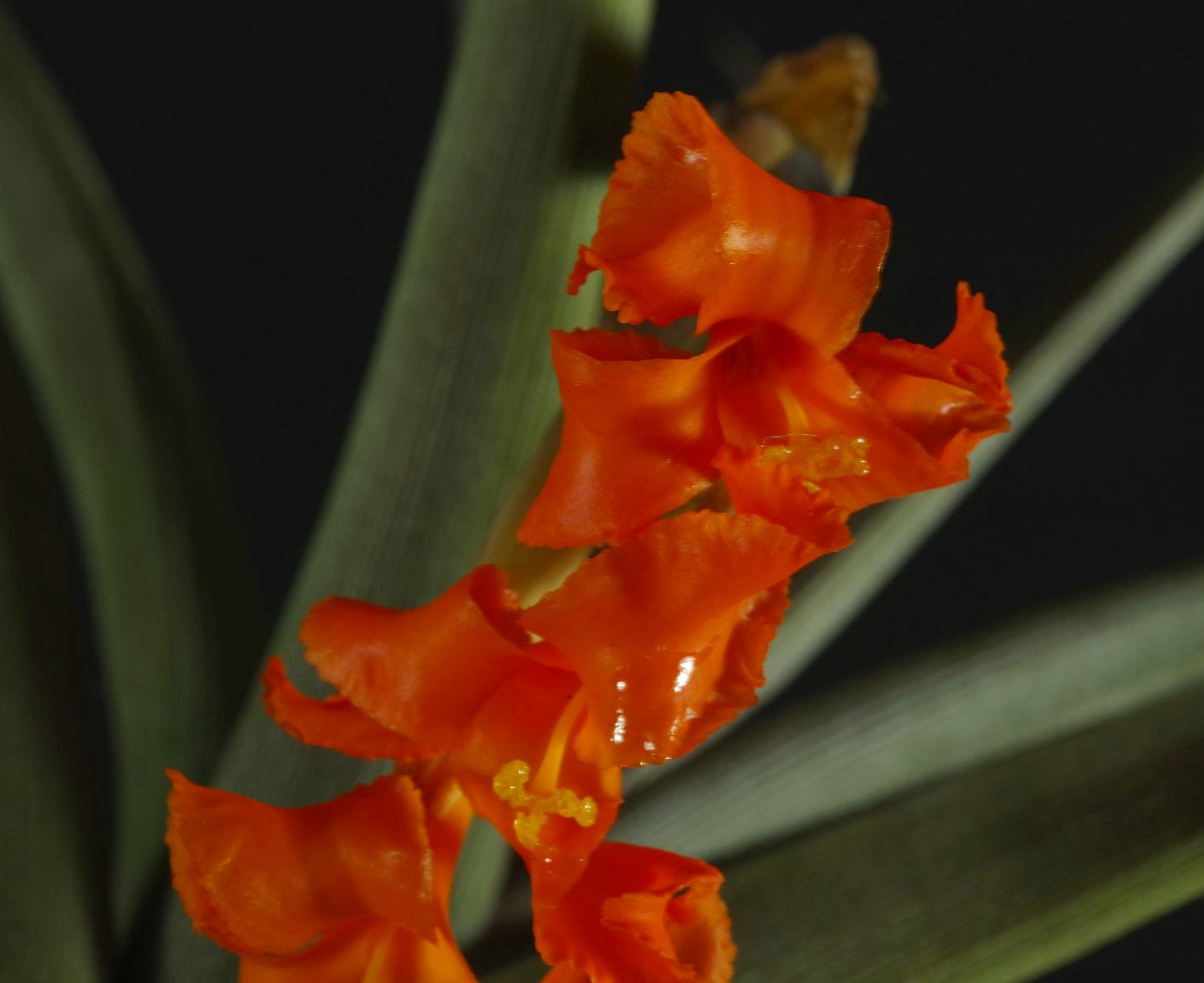

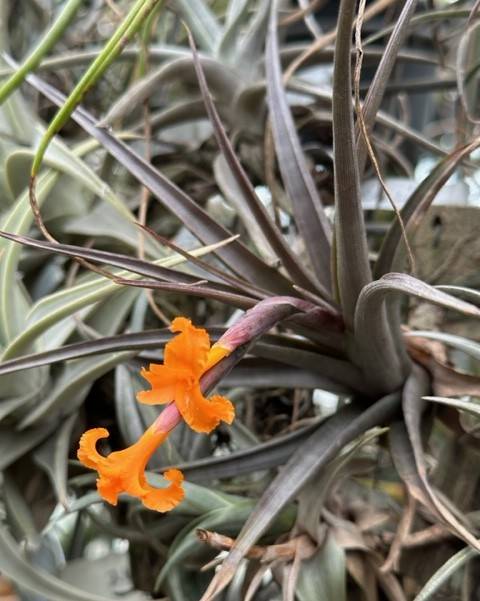
Typus: Bolivia, Prov. Mendez, in declivis septentrionalibus Rio Pilaya versus, 1800 - 2200 m s.m., epiphytica, 31. 10. 1996, leg. Gerda & Erich Haugg 11247 et. Ewald Heger (Holotypus: WU).
Plant single or growing in small groups, flowering 12-22 cm high, to 25 cm diameter, stemless, forming an almost erect rosette with 12-20 leaves.
Leaves - polystichous, 10-12 cm long, the lower ones often shorter, almost erect, the blade spreading out, thin leathery, strongly nerved, dark reddish, both sides fine appressed grey scaled, appearing brownish red.
Sheath -2.5-4 cm long, 1.4-2 cm wide at the base, indistinct from the blade, triangular oval.
Blade - 8-10 mm wide next to sheath, 6-18 cm long, narrow triangular acuminate, tapering to a very thin subulate, somewhat sharp tip, the edges strongly bent, both sides very fine appressed scaled, inside weaker, outside very strongly nerved and frosted, when dry both sides prominently nerved.
Scape very short, 3-4 cm long, ca 4 mm diam. , bent over, a few scape bracts densely imbricate on the scape, to 3.5 cm long, leathery, the bottom ones caudate and similar to the rosette leaves, the upper ones similar to the flower bracts, acute.
Inflorescence - terminal, simple, distichous, complanate, not exceeding the rosette, 4-7 cm long, 8-20 mm wide, (post floral to 3 cm ) lanceolate or elliptic acuminate somewhat bent over, 1-7 sessile, scentless flowers and 1-2 sterile bracts at the base.
Rhachis - almost straight, green, four edged, glabrous.
Floral bracts - imbricate, rhachis not visible, 1.8-3.5 cm long, exceeding the sepal, 8-11 mm. wide, narrow oval, acute, thin leathery, not keeled, nerved, (in the dry state strongly nerved), reddish green, shiny, glabrous.
Sepals - 18 - 23 mm. long, 6 - 8 mm. wide, elliptic, acute, free, the posterior ones thickly keeled, light green, very thin membranous with wide hyaline, almost transparent edge.
Petals - 4 cm long, the platte 9 mm wide, the edges very strongly waved and serrated, narrowing to 3 mm at base, the throat opening, the tip strongly spreading, bright orange yellow.
Stamens - enclosed in the flower, sometimes as long as the flower tube, Filament 2.5 cm long, ribbon like filiform, thin, straight, yellowish white, the top portion yellow, Anthers 4-5 mm long, 0.4 mm wide, linear, joined at the base, yellow,
Pollen egg yellow.
Style 3 cm long, thin, bottom whitish yellow, yellow towards the top, Stigma 14 mm long, with 4 mm long, 0.2 mm wide, orange lobes and lcm long thin stem, strongly spreading somewhat papillose.
Ovary - 5mm high, 2.2 mm wide, the bottom conical 3 angled, light green.
Type locality - Bolivia, Province Mendez North of Rio Pilaya, 1800 - 2200 m, epiphytic, leg. Gerda and Eric Haugg and Ewald Heger, 31 - 10 -1996 EH 11247
Differs from T. argentina in
1. Plant larger
2. Leaves broader, not secund much more soft and thin, red - brown , prominently nerved
3. Inflorescence longer and broader
4. Floral bracts longer, densely imbricate, rhachis not visible.
5. Sepals longer
6. Petals orange yellow, not pink, longer, blades up to 9 mm wide, serrate, wavy.
Article by Erich Haugg in Die Brom. 1: 18-19. 1998
Already on three trips, I tried to explore Rio Pilaya in a northerly direction from Tarija. In 1996, as we were in this region again, I planned on an excursion of four days. It was a great surprise to find a road going throught it.
Starting in November is the mid Bolivian dry period. In the region of Tarija it is still dry but large thunder clouds gathered in the evening although without raining. At the Condor-Pass, where we found the Tillandsia mollis Hromadnik in 1982, it was so dry that only very isolated areas and after long searches found a few Rebutia heliosa Rausch. Already in the region of Santa Ana we decided to take our Landrover further north. On a mountainside at 2200m, we found a splendid, in habit somewhat like a small Tillandsia xiphioides Kerr.
We arrived in Tarija and after obtaining food supples and getting a necessary car repair I visited the German Consul, who was known to me from a previous trip. I remembered that on a previous trip the road to San Lorenzo was bad and even with our Landrover would be difficult to use.
Shortly after San Lorenzo, we stood in front of a signpost! What a surprise, because it is rarely seen in Bolivia and now we saw this achievement of modern time. It was the road to Trancas, a small place in the northwest. But this excursion brought no new finds. So we drove northward again and full of expectations. A well built road along in the valley continued to rise soon to 2800m. On this mountain, we found Sulcorebutia tarijensis, an occurrence about 50km from the type locality. Up and down, we look for an overnight stopping place. Again, huge thunderclouds conglomerate, from the distance we hear the rumble of thunder. But apart from some drops, we get nothing.
On the morning of 31 October after breakfast searching in the close surroundings we find a new Sulcorebutia, as well as a new Parodia. Naturally, the enthusiasm is great. Here the wide road narrows visibly. With many stops, we find another unknown Sulcorebutia as well as later many Mediolobias. The road always between 2400 and 3000m. On the way we find another form of Puya hromadnikii Rauh, or is this also something new? Once again at 3000m, we see the river Rio Pilaya far below. The road has meanwhile become an extreme track. But our Landrover experience soon sees us through this. At about 2200m, we find the first leafless trees and then fully surprised at 2000m a very hard, sharp silver Tillandsia. On leaving, we observe Lobivia haemantha, Echinopsis kermesina, Gymnocalycium pflanzii and Parodia procera. At the Rio Pilaya, at 1300m, then Neoraimondia herzogiana (previously Neocardenasia) then Opuntia spec. and Eriocereus spec. (now harrisia) as well as Tillandsia duratii Vis. We drive through the river and reached Carapari but could go no further by car. Later we were obliged to take the north connection above Incahuasi, because the river systems of the Rio Pilcomayo were closed towards Cruz. There are still chances for the plant person to discover more.
With the return trip, naturally, some examples we collected of the new Tillandsia, this plant is found only in small numbers at a height difference of 50m. However, they occurred along the slope over a wide stretch.
To have made this discovery is somewhat lucky, the other fellow travellers have driven past the plants without having seen them. In the evening, this so successful day was long spoken about a good bottle of red wine.